 |
| Tutorial: Hand Papermaking |
These are the resources you will need in order to make paper:
- a water source
- an electricity source
- a blender
- a Rubbermaid dishwashing pan (or some other deep pan)
- a towel
- shop towels - you can buy these in a roll at any auto supply store. They look like blue paper towels, but they are made of cloth and can be washed and used again. Don't use paper towels for this!
- a paper mould (buy one from me, or follow my tutorial on how to make one)
- a sponge
- a folding clothes-drying rack
|
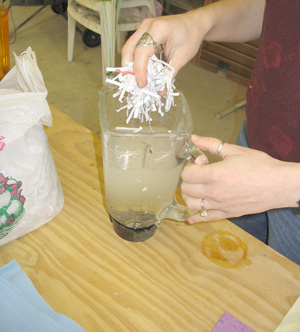 |
I have a small paper shredder in my office. The plastic bag next to the blender in this photo has the shredded paper in it. I filled the blender jar about 3/4 of the way with warm water. (It was cold in the basement, and I didn't want to be sticking my hands in cold water. That's the only reason I used warm water; cold water works just as well.) Then I added two or three small handfuls of the shredded paper. Better to have too little than too much; you end up adding a blenderful or two of just water to the bin anyway to dilute the pulp, and you don't want to make your blender work too hard and burn itself out. |
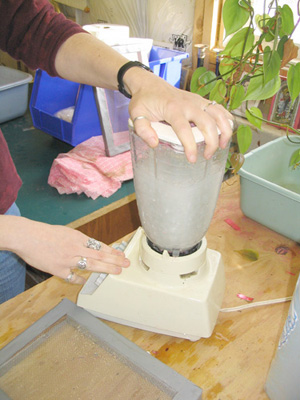 |
I blended the scraps for maybe 30 seconds, until I can hear that the blades aren't straining against clumps. When the blender stops and you peer at the pulp, it shouldn't look chunky. It should look more like a milkshake. |
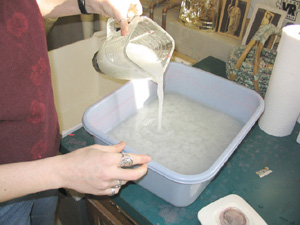 |
I pour the pulp into a Rubbermaid dish pan. This is a good size for the paper mould that I use (the mould I have makes sheets 6"x9" in size), and it's nice and deep. It takes about four blenders to get enough pulp in the bin, and as I said, I usually add another blenderful or two of water to make the pulp deep enough for maneuvering. |
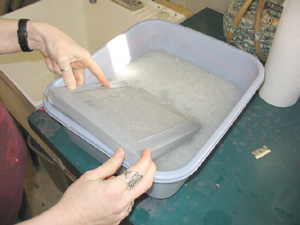 |
I handmake my paper moulds, but there are companies that offer ready-made ones that work fine too. This one is made with 1"x1" wood strips nailed into a rectangle. Aluminum screening is cut to fit and staple-gunned along the top of the rectangle. Duct tape is placed over the staples to create a smooth surface that won't cling to the paper. You'll get another view of the paper mould in the next few photos. |
 |
Keeping the staple-gunned surface on the top, push the paper mould into the water, and pull it up straight so that a layer of paper pulp forms on the top of the screen. If it is clumpy, or if you can see the screen through the pulp or if the screen is uncovered in some area, put the pulp back into the bin, mix it with your hand, and try pushing the paper mould back into the water and pulling it up again. |
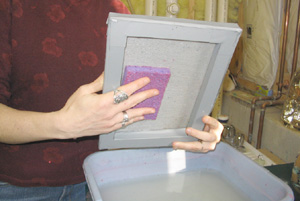 |
Hold the paper mould at an angle over the dish bin, and let some of the water run off. Use the sponge to gently press on the back side and take off more water. Don't push hard! The screen is only adhered by staples, and if you press hard, it will eventually weaken the staples. Squeeze out the sponge when it gets too wet, and dab at the back until you feel like you've taken off any water that drips. |
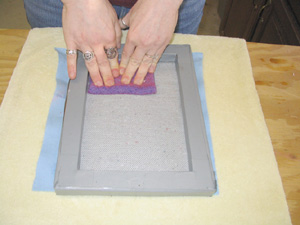 |
The paper is pretty well adhered to the screen at this point. You can turn the paper mould upside down, and it won't slide off. So take your time, turn the paper mould over, center it over the shop cloth (previously placed on top of the towel) so that the paper side is pressed onto the shop cloth. You are separated from the paper by the screen. Press on the screen hard with a sponge, and push as much water as you can out of the paper and into the towel. The pressing is what causes your paper to be flat and sturdy, so press hard! |
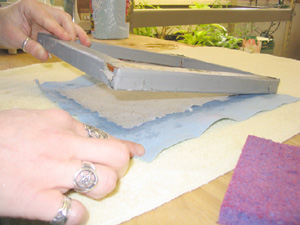 |
This is the trickiest part. Lift the paper mould just the tiniest bit off the towel. Just barely. And blow hard through the screen along the portion of the mould closest to you, until the paper starts to separate from the screen. If you lifted the mould too high, the paper may curl under and stick to itself, so that's why I say just pick it up a tiny tiny bit. Once it starts to separate, you can lift the whole mould off the sheet of paper. |
 |
Now the paper should be adhered to the shop cloth. If you pick up the shop cloth and the paper starts rolling off, stop immediately and just let it dry flat. |
 |
In this case, though, the paper stuck nicely to the shop cloth, so I clothespinned it to my laundry rack. The other sheets I will make will hang to dry as well. |
|
The sheets tend to dry in the shape of a potato chip, with the center bulging down. I use a steam iron and iron them flat after they dry, and then pull them off the shop cloth. (You can iron directly on the paper, or you can flip the shop cloth over and iron the paper through the shop cloth.) The shop cloths can be laundered and used again. |
 |
©
Copyright 2007. All rights reserved.
Contact: Donna Albino |










